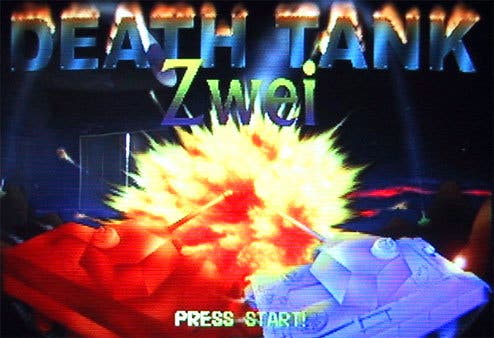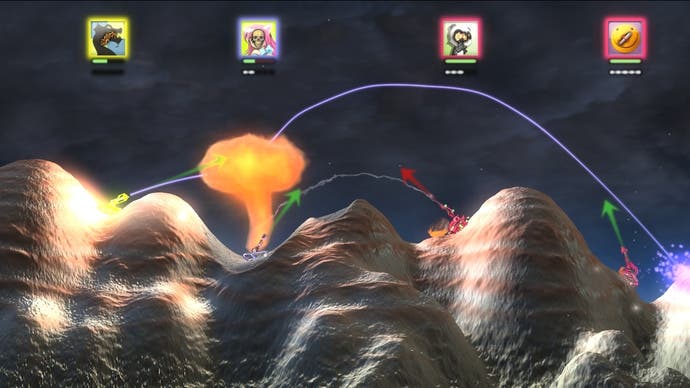Death Tank's Ezra Dreisbach
On Lobotomy, Powerslave and why the Saturn was crap.
This week's Xbox Live Arcade release is an updated version of the legendary Death Tank, one of the most celebrated, and yet under-played party games ever developed. Devised and programmed by Ezra Dreisbach of Lobotomy Software, the full DT experience is difficult to convey, but it's usually described as a kind of real-time version of Scorched Earth or Worms, as if that's enough to convey the refined, distilled genius of this game. It isn't.
Of course, chances are that you've never played it, because getting access to the game was an ordeal in itself. To access the original version required a US copy of Saturn title Exhumed (aka Powerslave) and you needed to completely vanquish the game, not just by defeating the final level but also by locating hidden "Team Dolls" dotted throughout the levels - a task worthy of a strategy guide in itself. Even after that, you needed the Saturn's eight-player multi-tap to get the full party experience. Things got easier when Lobotomy released its Saturn conversions of Duke Nukem 3D and Quake, which auto-unlocked the improved Death Tank Zwei if you had an existing save-game from another Lobotomy release on your system.
Criminally under-exposed, under-played, and under-appreciated for a game some believe to be a classic of its era, Ezra Dreisbach has spent the last three years re-coding and retooling Death Tank from scratch exclusively for Xbox 360 with full Xbox Live support, brand new single-player game variations, and a handsome new set of graphics. Even the free trial version is rather good.
When Microsoft offered us the chance to talk to Ezra, we jumped at the chance. Aside from the excellent Death Tank, Lobotomy Software produced some of the most technically advanced software of its time, defying John Carmack's belief that Quake could never be converted to the Saturn. The company's PlayStation output - although limited - was similarly excellent, with the conversion of Exhumed/Powerslave proving to be even better on the Sony console than the Saturn original.
In this interview we step back in time, Kylie-style, to the mid-'90s, to the height of the Saturn/PlayStation rivalry, extract the full juicy details of the era from Lobotomy's perspective, and find out why the SEGA machine really was an "insane abortion". Then, remembering that we have an excellent new game to champion, we warp back to the present day and go in-depth on Death Tank for Xbox Live Arcade, and let the programmer tell you why he thinks it's worth 1200 of your precious Microsoft Points.

That's really pretty inaccurate. The creative side of Lobotomy came from Nintendo, but the engineering side came from Manley and Associates, an early Seattle area game company. Lobotomy was my first gaming job, so my game programming heritage is really Manley by way of Lobotomy programmers Jeff Blazier and John Yuill.
Japan was still the real centre of console game development in those days and Japanese mostly didn't care about first-person shooters. So there wasn't a lot of other console FPS development effort. Later when Lobotomy made the Duke/Quake Saturn ports, people had got good at the PlayStation, but hardly anyone outside Japan cared about Saturn.
The main different thing about console FPS of that era is that every wall has to be diced into a grid of polygons. This is because there is no perspective-correct texture-mapping and, in the case of the Saturn, no way to clip. You really needed some custom tools to deal with/take advantage of this, and Lobotomy had Brew (made by David Lawson).
I didn't exactly oversee anything. Jeff Blazier programmed the entirety of Lobotomy's PlayStation output. But it's not hard to tell the PlayStation is better.

The Saturn was really an insane abortion. The graphics hardware was made by guys that obviously wanted to just keep developing 2D hardware and tried to avoid learning anything about 3D. So they made this thing that was totally different from what everyone else in the 3D community was doing and missed some real key ideas, making some things (clipping) impossible.
And then the rest of the system had a whole other batch of warts caused (according to the internet) by a hasty pre-launch upgrade to match the PlayStation. They threw a whole bunch more parts in the box, and none of them worked out that great. The second processor in particular made it both more difficult to program, and impossible to fully utilise.
This probably ultimately doomed the Saturn. With so much different crap jammed in the box, it never got cheap for them to produce it.

